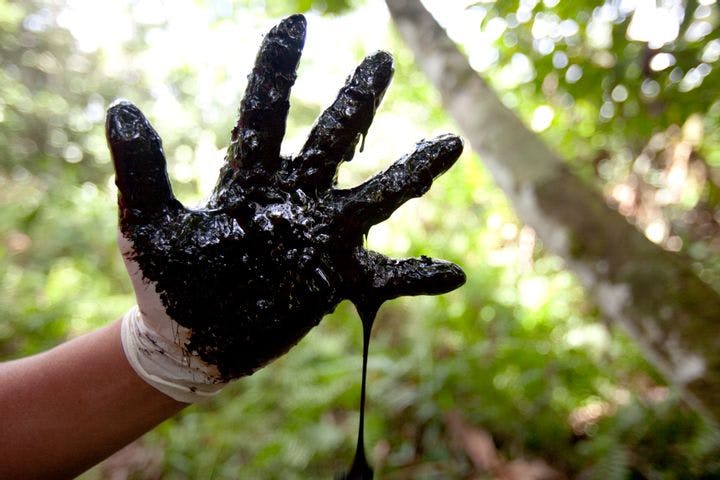How the Amazon’s Indigenous Population is Coping with Oil Drilling
– Erin Amato
For both developers and conservationists, Peru's example is a test of whether oil drilling can coexist with the fragile balance of nature. The livelihood of indigenous people proves even more fragile.
Deep in the Peruvian Amazon, the Las Malvinas gas plant sits along the Urubamba River, extracting and processing 1.6 billion cubic feet of gas every day. Visitors to the site are greeted with a list of “don’ts” mandated by Pluspetrol, the Argentine firm which runs this plant (which is Peru’s largest energy source). Among those commandments: workers must avoid making contact with the indigenous residents of the forest that surrounds the drill sites.
Many activists claim that Pluspetrol is threatening the very survival of these protected tribes. Block 88, the prime area for drilling, is housed mostly within the Kugapakori-Nahua-Nanti reserve established by the government in 1990 to preserve the land of indigenous Amerindians.
Advocates like Peruvian NGO leader Vanessa Cueto believe that “there is a serious risk to people in initial contact,” especially since the government has lowered conservation standards. Pluspetrol now has government approval to build six new wells and conduct routine seismic tests on this untouched land.
For both developers and conservationists, Camisea is a test case to see whether the extraction of oil and gas can coexist with the fragile balance of nature. The livelihood of indigenous people proves even more fragile: illegal loggers began using an access road built by Shell in the 1980s to exploit the isolated Nahua Indians — more than 300 of whom died from diseases due to lack of immunity.
Since that tragedy, the Inter-American Development Bank has made loans to Camisea contingent on meeting rigorous environmental standards. In Block 88, drilling sites are accessible only by helicopter and constructed to allow horizontal drilling (thus disrupting as little surface area as possible). Maximizing the land area for mature forests, the company asserts that they have never came into contact with any indigenous peoples.
To aid Camisea, an NGO employs a small team of Machiguenga Indians to monitor the environment. According to Cristóbal Rivas, the non-profit's president, they have carried out investigations into small leaks of diesel (though there is scant evidence of any incidents that will meaningfully damage the forest). At the same time, the Peruvian government has grown increasingly aware of the challenges faced by indigenous peoples, and has responded by (among other actions) banning seismic testing in the northwest corner of the block and placing limits on night working to avoid interference with tribal hunting practices.
In spite of all these investments, relatively little is known about the actual day-to-day realities of life in Block 88’s indigenous world. Claims about the relative well-being of the indigenous peoples of Peru rely on “out of date and incomplete studies,” says James Anaya, special rapporteur of the UN on indigenous rights. Similarly, Anaya notes that claims about the impact of the Camisea expansion are “speculative and imprecise.” He urges further exploration of native communities, and even a consultation with those in contact with Pluspetrol.
Among those who do favor the Camisea expansion? Chief Dispupidiwa Waxi of 470 Nahua Indians is a vocal booster for expansion and the jobs it would create in his area. He has traveled as far as Washington, DC to testify against NGOs that are in favor of quelling expansion. The Nahua intend to use the compensation to fund better classrooms and a community nurse.
Conversely, other indigenous rights advocates strongly oppose expansion: Mary Luz Trigoso, a Machiguenga environmental monitor, believes that the positive aspects Chief Waxi identifies may be true, yet they do not come without powerful consequences. Local and regional governments have pocketed half of the Camisea royalties. As a result, the improvements in secondary school remain unfinished.
How will indigenous rights impact Peru’s future? As long as the benefits of cheaper gas continue to drive Peru’s economy, native communities will unlikely be able to live life according to their traditions. These communities “can’t go back, like it or not. History has taken its path and the people too,” notes Patricia Balbuena, deputy minister with responsibility for indigenous peoples. Clearly, any expansions in Peru’s gas industry must be accompanied by respect and tolerance for the dignity of the indigenous inhabitants so vital to Peruvian culture.
The Source: “Energy and the Amazon: Drilling in the Wilderness” in The Economist, April 26, 2014.
Photo courtesy of the Rainforest Action Network
